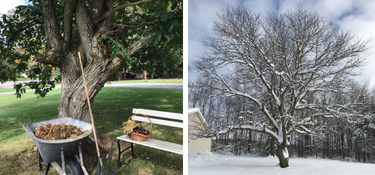 In the middle of my yard stands a majestic American chestnut tree. Virtually extinct for decades (1), this mature treasure is now a rare find, considered one of the most perfect of trees, with every part having great utility and beauty. I have learned a lot from that tree. The tree has been there for the nearly three decades I have called this place “home” and most likely a century prior.
In the middle of my yard stands a majestic American chestnut tree. Virtually extinct for decades (1), this mature treasure is now a rare find, considered one of the most perfect of trees, with every part having great utility and beauty. I have learned a lot from that tree. The tree has been there for the nearly three decades I have called this place “home” and most likely a century prior.
With the budding of the tree, in early spring, comes the distinctive hoppy aroma detected only in a microbrewery or near the American chestnut, appropriately located in my backyard. As we move into summer, the thick, matte leaves provide wonderful shade. In the early 1990s, when our son was young, a sturdy lower branch supported the hefty tire swing, providing hours of entertainment. As the years went on, the tree grew taller and the trunk girth increased. The older, lower branches died and were knocked down by storms, prophetically coinciding with the graduation of our son from the swing to his adolescent years.
Birds, squirrels, and “chippies” love the tree. Many feeders have found prime real estate among the branches, with the most recent “Squirrel Solution 200” (2) needing repair after an encounter and modification by a visiting bear.
By mid-summer, the distinctive fluorescent green husks, each containing the potential for three mature nuts, start appearing in clusters. As they grow to the size of tennis balls, the occasional small husk will fall — its spiny, outer coat surprising an unsuspecting barefoot, the fruits inside never reaching their full potential. By the end of September, the first maturing husks will split slightly and fall from the tree. Each vessel holds three nuts. Early in the season, very few have matured. By mid-October, thousands of husks fall with many containing one, occasionally two, and (jackpot!) three mature chestnuts. The remaining smaller “sisters” I call “deer candy.” After further prying the husks (sometimes using the “two-shoed method” of stepping on the prickly armor), the contents are released. Occasionally a husk will split the whole way open, releasing the contents during the 50-foot free-fall. Gathering mature, rich brown chestnuts has always been a highlight of peak fall. The bounty is shared with friends and neighbors, roasted for a seasonal treat, surrendered to the wildlife in residence, and forced into dormancy for planting in the spring.
Then, there are the husks – thousands and thousands of spiny, lawn-mower-assaulting, greenish-brown grenades covering the lawn beneath the tree. For the first 26 years, I lived in my home, my husband had the responsibility of lawn maintenance, including “nut patrol.”
When my husband left this earth in the early spring of 2020, not so ironically under the chestnut tree, buds had not yet emerged on the leaves. In fact, it was a late year for the buds to emerge and the distinctive aroma to fill the air. Despite the delay — the pause — thousands of husks appeared. And when fall arrived, the harvest was just as bountiful as previous years.
Like for so many others, 2020 was challenging for me — and trying to manage my life, let alone the chestnut tree, was overwhelming. I’ll admit … it was out of control. Bags upon bags of unhusked nuts were thrown away. Minor damage to “J.D.” (my distinctive green and yellow companion with a 54-inch mowing deck) and several spines from husks embedded in my skin (with a few getting infected) contributed to the never-ending battle and my daily sentence of “having to” rake the nuts.
Somehow, I managed to transition into the winter. The barren, snow-laden boughs were brought to life with birds, including bright red cardinals. Deer ventured to forage for stray “deer candy.” Both brought me company.
In spring 2021, with the first “heaven-versary” of my life partner, the buds and the scent emerged on cue. I placed a bench under the tree where the tire swing hung nearly three decades prior. I entered autumn with a plan — and a pair of heavy leather gloves — to harvest and share the nuts, dispose of the husks (leaving some “deer candy” for my woodland companions), and protect dependable “J.D.”
Now, I get to rake the nuts. I am amazed by the bounty, grateful when I unhusk a mature gem, and excited to find “twins” and “triplets.” However, no matter how well I plan or how long I rake, the husks fall faster than I can collect them, occasionally falling on my head (I call that “crowning”) while I’m beneath the tree.
And so is life. We work through seasons, adapt to our situations, accept pauses when necessary, assemble and maintain the proper tools, create and modify strategy, search for potential, share our blessings, find a purpose for what is no longer needed, and replace “I have to” with “I get to.”
Learn more about the glorious American chestnut tree at:
https://www.sierraclub.org/sierra/2021-2-march-april/feature/demise-and-potential-revival-american-chestnut
1. https://www.usda.gov/media/blog/2019/04/29/what-it-takes-bring-back-near-mythical-american-chestnut-trees
2. https://bromebirdcare.com/squirrelsolution200/
